
Driftless Area National Wildlife Refuge is a United States National Wildlife Refuge in northeastern Iowa, southwestern Wisconsin and northwestern Illinois. It is a non-contiguous collection of parcels in the vicinity of the Upper Mississippi River National Wildlife and Fish Refuge.

Natural Bridge State Resort Park is a Kentucky state park located in Powell and Wolfe Counties along the Middle Fork of the Red River, adjacent to the Red River Gorge Geologic Area and surrounded by the Daniel Boone National Forest. Its namesake natural bridge is the centerpiece of the park. The natural sandstone arch spans 78 ft (24 m) and is 65 ft (20 m) high. The natural process of weathering formed the arch over millions of years. The park is approximately 2,300 acres (9 km2) of which approximately 1,200 acres (5 km2) is dedicated by the Office of Kentucky Nature Preserves as a nature preserve. In 1981 this land was dedicated into the nature preserves system to protect the ecological communities and rare species habitat. The first federally endangered Virginia big eared bats, Corynorhinus townsendii virginianus, recorded in Kentucky were found at Natural Bridge State Resort Park in the 1950s.

The Santa Cruz cypress is a species of North American tree within the Cypress family. The species is endemic to the Santa Cruz Mountains within the Santa Cruz and San Mateo counties of west-central California. The U.S. Fish and Wildlife Service listed the species on the Endangered Species Act in 1987 due to increasing threats from habitat loss and disruption of natural forest fire regimes. In 2016, the conservation status of the Santa Cruz cypress changed to Threatened. The cited reasoning was a decrease in threats against their habitat.

The Salt River is a 150-mile-long (240 km) river in the U.S. state of Kentucky that drains 2,920 square miles (7,600 km2). It begins near Parksville, Kentucky, rising from the north slope of Persimmon Knob south of KY 300 between Alum Springs and Wilsonville, and ends at the Ohio River near West Point. Taylorsville Lake is formed from the Salt River, and Guist Creek Lake is also in its drainage basin.
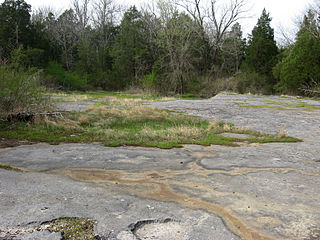
A calcareous glade is a type of ecological community that is found in the central Eastern United States. Calcareous glades occur where bedrock such as limestone occurs near or at the surface, and have very shallow and little soil development. Due to the shallow soil and the extreme conditions created by it, trees are often unable to grow in the glades. This creates a habitat that is usually sunny, dry, and hot. Calcareous glade vegetation is more similar to that of a desert habitat than a grassland, being dominated by small spring annuals with occasional geophytic or succulent perennials.

Yermo xanthocephalus commonly known as the desert yellowhead is an American flowering plant endemic to southern Wyoming. It is the only member of the genus Yermo and was first described in 1991.

Echinacea tennesseensis, also known as the Tennessee coneflower or Tennessee purple coneflower, is a flowering plant in the family Asteraceae, endemic to the cedar glades of the central portion of the U.S. state of Tennessee.

Eriogonum longifolium var. harperi, also known as Harper's buckwheat or Harper's umbrella plant, is a dicot of the family Polygonaceae, found in areas of nutrient-poor shale soils in Alabama, Kentucky and Tennessee. It lives inconspicuously in an immature vegetative stage for four or more years before developing a flowering stalk, then flowers and dies. It is listed as an endangered species by the state of Tennessee. It has eleven small populations in Alabama and five in Tennessee but its survival in Kentucky is uncertain. According to a leading expert, Professor James L. Reveal of the University of Maryland, its Kentucky population has been reportedly extirpated. Its 2006 Alabama Natural Heritage Program ranking was G4T2S1, demonstrating an opinion that it was "critically imperiled" in that state.
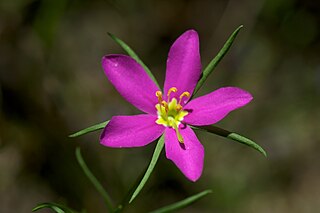
Sabatia arkansana, commonly known as Pelton's rose gentian, is an herbaceous annual in the gentian family. It was discovered in 2001 in several glades of the Ouachita Mountains in Saline County, Arkansas by John Pelton, a retired mechanic turned amateur photographer and naturalist. It is known only from two locations in this county and is considered critically imperiled as a result of the presence of nearby housing developments and due to the absence of a fire regime. In summer it shows attractive rose-purple flowers.
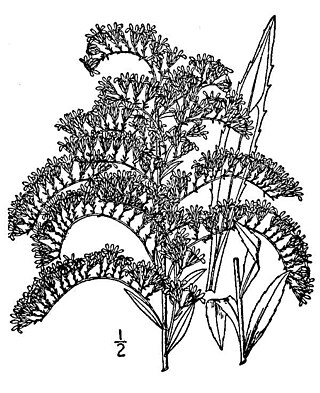
Solidago shortii, commonly known as Short's goldenrod, is a species of goldenrod in the family Asteraceae. The only known populations of Short's goldenrod occur around the Blue Licks Battlefield State Park area of Kentucky and Harrison-Crawford State Forest in Indiana. It was listed on the Federal Register of Endangered Species on September 5, 1985, and was given a global rank of G1 on February 29, 2000.
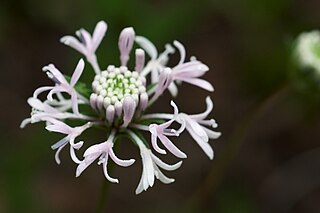
Marshallia mohrii, or Mohr's Barbara's buttons, is a perennial herb species, endemic to the Southeastern United States, in several locations in Alabama, Georgia, and Florida. The first recorded discovery of the species was in 1882 by Dr. Charles Mohr, hence the botanical species name and common name.
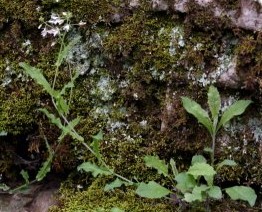
Boechera perstellata is a rare species of flowering plant in the mustard family known by the common names Braun's rockcress and Nevada rockcress. It is native to Kentucky and Tennessee, where it is known from perhaps 25 total populations. Most of the occurrences have few individuals, and all are deteriorating in quality. The plant grows in shady forest habitat on limestone substrates, usually near streams or rivers. This is a federally listed endangered species of the United States.

Clematis socialis is a rare species of flowering plant in the buttercup family known by the common name Alabama leather flower. It is native to the US states of Alabama and Georgia, where it is known from only five populations. The species is seriously threatened by habitat destruction. It is a federally listed endangered species.

Eriogonum gypsophilum is a rare species of wild buckwheat known by the common names Seven River Hills buckwheat and gypsum wild buckwheat. It is endemic to the state of New Mexico in the United States, where it is known from only three sites in Eddy County. It is limited to a specific type of soil which is high in gypsum. The plant has been federally listed as a threatened species of the United States since 1981.
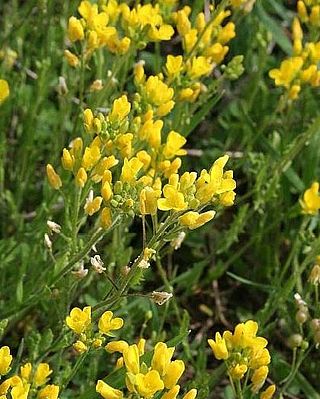
Paysonia lyrata is a rare species of flowering plant in the family Brassicaceae known by the common name lyreleaf bladderpod. It is endemic to Alabama in the United States, where it is known from only three occurrences. It is federally listed as a threatened species.

Physaria filiformis is a rare species of flowering plant in the family Brassicaceae known by the common names Missouri bladderpod and limestone glade bladderpod. It is native to Missouri and Arkansas in the United States. It was federally listed as an endangered species in 1987 and it was downlisted to threatened status in 2003. P. filiformis remains listed as an endangered species at the state level in Missouri.
The Wee Jasper Nature Reserve is a protected nature reserve that is located in the Southern Tablelands region of New South Wales, in eastern Australia. The 630-hectare (1,600-acre) reserve is situated to the west of the Goodradigbee River arm of Burrinjuck Dam near the rural locality of Wee Jasper.

The Interior Low Plateaus are a physiographic region in eastern United States. It consists of a diverse landscape that extends from north Alabama across central Tennessee and Kentucky into southern Illinois, Indiana, and Ohio. Its natural communities are a matrix of temperate forests, woodlands, and prairies.

Acanthomintha ilicifolia, known by the common name San Diego thornmint, is a rare species of flowering plant in the mint family. It is native to Baja California and San Diego County, California, where it is a resident of the chaparral and coastal sage scrub plant communities and vernal pools.
Leavenworthia exigua, also known as the Tennessee gladecress, is a member of the mustard family. Tennessee gladecress is an annual plant that is native to southern United States. It is a fruit-bearing plant, with squarish leaves that fall off one the fruit is present and ripened. Tennessee gladecress is a beautiful plant during its blooming season, as it produces a light-lilac colored, small flower.
















